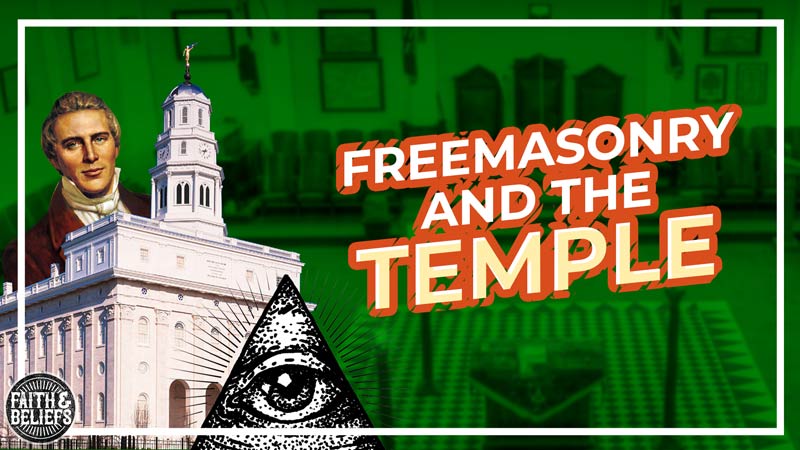https://youtu.be/PhjBefSrqnE
Hey guys, welcome back to another episode. Today we’re going to talk about the relationship between the Latter-day Saint temple endowment and Freemasonry. We’ve got no time to waste. Let’s jump right in.
So, whether you’ve been through the temple or not, you may have heard that there are some similarities between our temple endowment and certain Masonic ceremonies. The danger of focusing on these similarities is that the vast differences get overlooked. The washing and anointing part of the endowment (which we’ve done a video on) has nothing to do with Masonry. The purpose of the endowment and the meaning of the covenants we make have nothing to do with Masonry. Similarities are limited to some symbols, actions, and wording.
Joseph Smith became a Master Mason in March 1842 and then administered the first endowment a few weeks later in May 1842.
In one way or another, Freemasonry absolutely influenced Joseph as he put together the endowment. Some people think that means our temple rituals are just ripped off of Masonry and that Joseph was a fraud. But the link between the two traditions was no secret to the early Saints. The first nine people to ever receive the endowment were all Masons, and none of them had a problem with the similarities. But there are several different ways modern Latter-day Saints understand why these similarities exist. The Church’s website talks about two of those perspectives. The first is this:
“Some Latter-day Saints point to similarities between the format and symbols of both the endowment and Masonic rituals and those of many ancient religious ceremonies as evidence that the endowment was a restoration of an ancient ordinance.” In other words, there are similarities because both traditions are based on ancient Christian practices.
But how can that be true when scholars only date Masonry back to the Middle Ages? Because despite when the organization began, as Robert Cooper, said, the majority of Freemason symbolism and iconography was “adopted from Christianity.” For example, Reverend Neville Cryer “concluded that Masonic signs originated with the set of gestures utilized by a few of the orthodox monastic orders. He felt that the catechetical instruction of Masonry was rooted in the method of monastic [or monastery] worship.”
So it’s entirely plausible that Joseph was right when he said that Masonry “was the apostate endowments, as sectarian religion was the apostate religion.” During the apostasy, we believe many aspects of priesthood and temple ordinances were fumbled and scattered across many faiths and traditions. The second interpretation the Church outlines is this:
“Others note that the ideas and institutions in the culture that surrounded Joseph Smith frequently contributed to the process by which he obtained revelation.” For example, God utilizes your culture and environment to reveal things to you in ways you’ll understand. And because people in Joseph’s day were very familiar with Masonry, aspects of it were utilized to more effectively present and ritualize the endowment.
Scholar Ben Spackman wrote, “Aspects of revelation…will strongly reflect their environment, and are a necessary part of that revelation, not a detriment to its revelatory quality. Environmental similarities may or may not indicate ‘borrowing’ or ‘remixing,’ but they don’t automatically preclude revelation.”
For example, you already know that the law of circumcision was given to Abraham as a sign or token of the Abrahamic covenant. But what you might not know is that Abraham was not the first person to practice circumcision. It already existed, for example, in Egypt. It’s probably not a coincidence that circumcision was implemented after Abraham’s visit to Egypt. God takes something familiar to Abraham and adapts it for another purpose. And that’s absolutely fine.
He did the same thing with the rainbow after the flood. It’s repurposed as a “token” of a covenant between Him and Noah. In the words of Spackman, “Jesus transformed water into wine. He didn’t produce it ex nihilo,” or out of nothing.
So, in review, why are there similarities between Masonry and our temple endowment? It could be that some elements of Masonry are based on ancient temple practices that God inspired Joseph to include. It may also be that God took some elements of Masonry and repurposed them for the endowment. And there are many people who think it’s a mixture of all of those possibilities, myself included. I think both traditions reflect elements of ancient Christianity, and I also think that Freemasonry helped Joseph give presentational and ritual scaffolding to the promises we make in the temple.
Speaking of the temple, there are also lots of questions about why temple ceremonies have changed over the years—I’m going to do a separate episode all about that so hold those questions until then. In the meantime, we’ve barely been able to scratch the surface of this topic—check out the resources in the description if you want to dive deeper, and have a great day.
Learning More:
- From the Church’s website: https://bit.ly/2qMEK87
- Fantastic video from past Saint Unscripted guest, Jeff Roundy: https://bit.ly/31L5bI5
- Another (longer) video from past guest, Brett McDonald: https://bit.ly/2JoMy6l
- Freemasonry and the Origins of Modern Temple Ordinances: https://bit.ly/2N3fXnF
- Similarities Between Mormon and Masonic Temple ritual: https://bit.ly/2wXzJaV
- Presentation by Greg Kearney: https://bit.ly/32PG2xk
- The First Nauvoo Temple (Historical background info): https://bit.ly/32Eu7SS
- On the adaptive nature of revelation, from Ben Spackman: https://bit.ly/31JJt75
- Circumcision in Egypt before Abraham (more in Spackman article): https://bit.ly/2JC8KKz
- Can Temple Ceremonies Change? (More in future episode): https://bit.ly/32DFJp9
- A few insightful quotes on this subject: https://bit.ly/2MJRO6B
- “Freemasonry and the Temple,” by Kenneth W. Godfrey: https://bit.ly/2ogKUwc
- “Was Freemasonry Derived From Mormonism?” by Eugene Seaich: https://bit.ly/2MLWU27
- Video from Chris Cunningham outlining more perspectives on this issue: https://bit.ly/2p4Nq9s
I highly recommend this book for a more comprehensive look at this issue: “Exploring the Connection Between Mormons and Masons,” by Matthew B. Brown.

